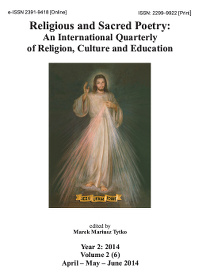Prayer in Contemporary Slovak Poetry (Current Genre Tendencies)
Prayer in Contemporary Slovak Poetry (Current Genre Tendencies)
Author(s): Jana JuhásováPublished by: Fundacja Naukowa Katolików »Eschaton«
Keywords: spiritual poetry; individualised spirituality; specifications of the contemporary poetic prayer (semantic as well as modal)
Summary/Abstract: The research paper “Prayer in Contemporary Slovak Poetry. (Current Genre Tendencies.)” examines the innovative practices of poetic prayer in Slovak literature. The study links literary, historical, and theological knowledge. In the background is the author's belief that the change of patterning of the literary prayer genre reflects important sociological shifts within the whole of society. This premise is tested on poetic texts from the turn of the 20th century, which reflect the transition from totalitarian ideology to liberal democracy. This period is marked by an increased occurrence of prayer in poetry which can be seen as a gesture of freedom of spiritual expression. At the same time there is a noticeable tendency to question the testimonial value of prayer poetry in the course of an expressing of rebellion against social and religious authority. Prayer poetry conveys the needs of individualized noninstitutionalised faith, mixing aspects of different religions, and the plea for closeness rather than transcending values “from the other world”. The core of the research paper is the analysis of four contemporary prayer poems published between 1992 and 2012. Through the choice of particular poems, the author aims to reach several goals: she wants to introduce key authors representing several lines of Slovak poetry (spiritual poetry, poets of privacy, non-conformist individualist, and experimental line – the so-called Text Generation) while presenting new semantic and structural practices that reflect significant trends in individualized Slovak poetry after November 1989. The texts present a creative, though not a value tension in respect to the genre of religious prayers. Colloquial expression, pragmatic tone, ironic understatement, toned-down testimony, philosophical analysis and latency are some of the preferred departure points. Pathos, emulating ideological frameworks or the position of an enlightened sage are features which typically receive criticism. At the level of expression authors deliberately work with concealment and latency. These features have an effect on the participants of prayer communication. Identification of the addressee of the text, which ultimately determines its genre, requires a contextual reading of the text and an awareness of its multi-dimensional nature. On the other hand, questioning the lyrical subject demonstrates the need for the understanding of the self, moving from ordinary, banal towards the high (sacred). Some poets (especially the Text Generation) use the prayer quotes to create assemblages. Fervent emotional involvement and carefree faith expressed through religious prayer enters into a dialogue with disparate visualization and complements the emotional restraint of contemporary man. Current genre trends of poetic prayer correspond with developmental trends of Slovak poetry in general.
Journal: Religious and Sacred Poetry: An International Quarterly of Religion, Culture and Education
- Issue Year: 2014
- Issue No: 2
- Page Range: 115-140
- Page Count: 26

